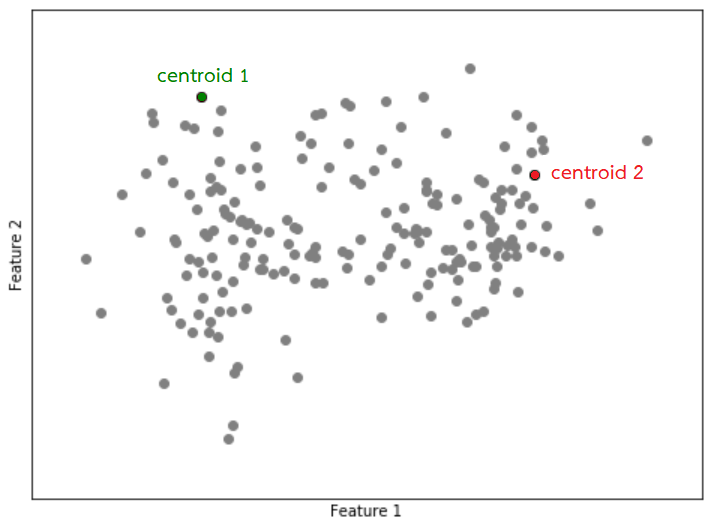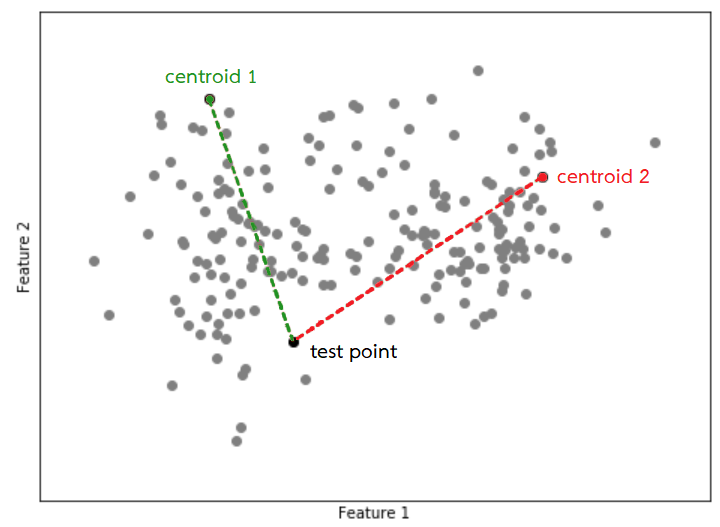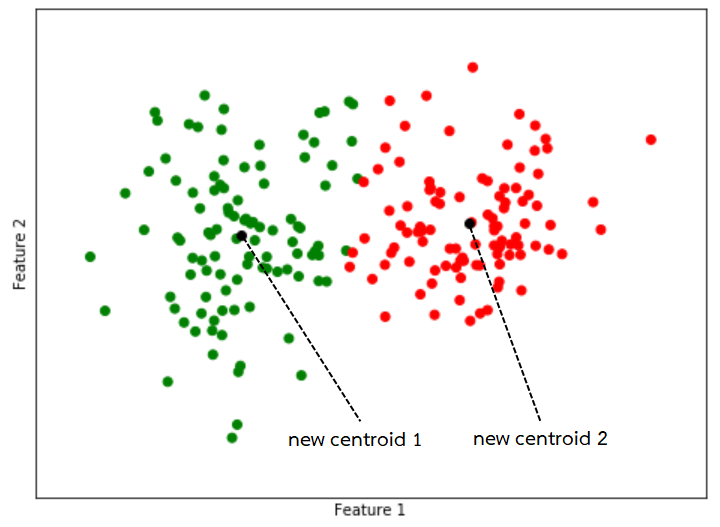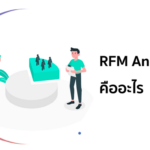สำหรับเทคนิคใน Data Science ที่จะมาใช้ในการแก้ปัญหาต่าง ๆ โดยอาศัยข้อมูลนั้นมีหลากหลายวิธี และในบทความนี้จะพูดถึงวิธีการใช้เทคนิค machine learning ในการแบ่งกลุ่มข้อมูล หรือ clustering algorithm ซึ่งเชื่อว่าโมเดลหลาย ๆ คนน่าจะนึกถึงเป็นอันดับแรกก็คือ k-means เพราะด้วยความเรียบง่ายของโมเดล และประสิทธิภาพของการแบ่งกลุ่มที่อยู่ในเกณฑ์ที่ยอมรับได้ k-means จึงเป็นที่นิยมและมักจะถูกเรียกใช้งานอยู่บ่อยครั้ง
โดยทั่วไปแล้ว k-means มีวิธีการทำงานโดยเริ่มจากการกำหนดจุดศูนย์กลางของกลุ่ม (centroid) มาจำนวน จุดโดยที่
คือจำนวนกลุ่มที่คาดว่าจะได้จากการแบ่งกลุ่ม จากนั้นคำนวณระยะห่างระหว่างข้อมูลในแต่ละแถวกับ centroid เพื่อใช้ในการจัดกลุ่มข้อมูล โดยระยะห่างนั้นสามารถคำนวณโดยใช้ Euclidean distance
โดยที่ และ
เป็นข้อมูลแต่ละแถวที่มีความยาว
หรือมี
ค่า ซึ่งสามารถเข้าถึงแต่ละค่าได้จาก index
ตัวอย่างเช่น การคำนวณ Euclidean distance สำหรับข้อมูลที่มีความยาว
ของ
และ
ทำได้ดังนี้
เมื่อจัดกลุ่มครบทุกแถวข้อมูลแล้วจะมีการปรับตำแหน่งของ centroid ในแต่ละกลุ่มใหม่ และจะทำวนซ้ำไปเรื่อย ๆ จนกว่าจะตรงตามเงื่อนไขในการหยุดการทำงาน ซึ่งสามารถสรุปเป็นขั้นตอนได้ดังนี้
1. สุ่มข้อมูลมา records เพื่อใช้เป็น centroid (ในกรณีนี้
)

2. คำนวณระยะห่างระหว่างข้อมูลแต่ละแถวเทียบกับ centroid ที่มีอยู่ จุด

3. จัดกลุ่มจุดข้อมูลให้ไปอยู่กลุ่มเดียวกับ centroid ที่อยู่ใกล้ที่สุด
4. ปรับตำแหน่งของ centroid ในแต่ละกลุ่มไปเป็นค่าเฉลี่ยของข้อมูลทั้งหมดที่อยู่ที่ในกลุ่มนั้น

5. ทำขั้นตอนที่ 2 ถึง 4 จนกว่าจะถึงเกณฑ์ที่ใช้ในการหยุด
แม้ว่าจะเป็นโมเดลที่ได้รับความนิยมมากหรือมีความเรียบง่ายแค่ไหนก็ตาม k-means มีข้อจำกัดอย่างหนึ่งคือสามารถใช้ในการแบ่งกลุ่มข้อมูลที่เป็นตัวเลข (numerical feature) ได้เท่านั้น เลยทำให้เกิดคำถามที่ว่า “จะต้องทำอย่างไรหากต้องการแบ่งกลุ่มข้อมูลที่ไม่ใช่ตัวเลข หรือข้อมูลที่เป็นหมวดหมู่ (categorical feature)”
เนื่องจากว่าในวิธีการทำงานของ k-means มีการคำนวณระยะห่าง ซึ่งถ้าข้อมูลไม่ได้มีแค่ตัวเลข แต่มีตัวอักษรหรือข้อความรวมอยู่ด้วย จะไม่สามารถทำในขั้นตอนที่ 2 และ 4 ได้ เพราะระยะห่างและค่าเฉลี่ยระหว่างตัวอักษรหรือข้อความนั้นไม่สามารถถูกคำนวณได้ด้วยสูตรแบบเดียวกันกับที่ใช้ในการคำนวณข้อมูลที่เป็นตัวเลข
อย่างไรก็ตาม Z. Huang1 ได้เอาชนะข้อจำกัดนี้ โดยเปลี่ยนการวัดระยะห่างสำหรับ categorical feature ใหม่ เป็นการวัดความคล้ายคลึงระหว่างกันแทน ซึ่งกำหนดว่าหากเป็นข้อมูลที่มีค่าเดียวกันจะให้ค่าเป็น 0 และถ้าเป็นค่าที่แตกต่างกันจะให้ค่าเป็น 1 และเรียกปริมาณนี้ว่า dissimilarity measure ()
โดยที่ และ
เป็นตัวอักษรหรือข้อความใด ๆ ยกตัวอย่างเช่น
เนื่องจาก ‘GBDi’ นั้นแตกต่างจาก ‘Big data’ และ
เพราะเป็นคำหรือข้อความเดียวกัน
ด้วยเหตุนี้จึงทำให้ปริมาณที่ใช้วัด “ระยะห่าง” ระหว่างข้อมูลแต่ละตัวกับจุด centroid ในแต่ละกลุ่มจะถูกเปลี่ยนแปลงตามไปด้วย โดยจะกลายเป็นส่วนผสมระหว่างระยะห่างจริง ๆ ที่เคยใช้ใน k-means หรือก็คือ Euclidean distance เพื่อคำนวณสำหรับ numerical feature และระยะหรือความคล้ายคลึงที่สร้างขึ้นใหม่ หรือก็คือ dissimilarity measure เพื่อคำนวณสำหรับ categorical feature ซึ่งสามารถเขียนเป็นสมการได้เป็นดังนี้
โดยที่ และ
เป็นข้อมูลแต่ละแถวโดยมี numerical feature อยู่
คอลัมน์ และมี categorical feature อยู่
คอลัมน์ และ
คือ weight ของ dissimilarity measure โดยตัวอย่างการคำนวณจะสมมุติให้
และ
โดยให้
ทำให้ได้ว่าระยะห่างระหว่าง 2 ข้อมูลนี้มีค่าเท่ากับ 6.5 ซึ่งมีวิธีการคำนวณ ดังนี้
เมื่อทำการแทนที่ระยะห่างใน k-means ด้วยปริมาณดังกล่าวก็ทำให้วิธีการในขั้นตอนที่ 2 กลับมาทำงานได้อีกครั้ง สำหรับขั้นตอนที่ 4 ที่มีการปรับตำแหน่งของ centroid ในแต่ละกลุ่มจะถูกแยกคิด ถ้าเป็น numerical feature ยังคงใช้ค่าเฉลี่ยของ record เหมือนเดิม แต่ถ้าเป็น categorical feature จะเปลี่ยนไปใช้ค่าฐานนิยม (mode) ของ record ทั้งหมดที่อยู่ในกลุ่มนั้นแทน โดยวิธีการที่ถูกพัฒนาขึ้นมาใหม่นี้มีชื่อเรียกว่า k-prototypes
แท้จริงแล้ว k-prototypes คืออีกรูปแบบหนึ่งของ k-means ที่ถูกพัฒนาให้รองรับ categorical feature ซึ่งถ้าข้อมูลที่ใช้เป็น numerical feature ทั้งหมด k-prototypes จะถูกเรียกว่า k-means และถ้าข้อมูลที่ใช้เป็น categorical feature ทั้งหมด k-prototypes จะถูกเรียกว่า k-modes
สรุป
k-prototypes ได้ถือกำเนิดขึ้นเพื่อรองรับการแบ่งกลุ่มข้อมูลที่ไม่ใช่ตัวเลข โดยการปรับปรุงวิธีการคำนวณความแตกต่างระหว่างข้อมูลใน k-means จากการที่วัดเพียงระยะห่างซึ่งสามารถคำนวณได้เฉพาะ numerical feature ก็ได้เพิ่มการวัดความคล้ายคลึงระหว่างข้อมูลสำหรับ categorical feature
หาก k-prototypes ถูกใช้ไปกับ numerical feature ทั้งหมด โมเดลนี้อาจถูกเรียกว่า k-means ได้ และถ้าถูกใช้ไปกับ categorical feature โมเดลนี้อาจถูกเรียกว่า k-modes
การใช้งาน k-modes และ k-prototypes ใน python
สามารถเรียกใช้งาน k-modes และ k-prototypes ได้ด้วย package kmodes โดยมี parameter ที่สำคัญ ดังนี้
n_clustersคือจำนวนกลุ่มที่คาดว่าจะได้จากการแบ่งกลุ่มmax_iterคือจำนวนรอบสูงสุดในการรันโมเดลinitคือวิธีการในการกำหนด centroid ในตอนแรก
3.1‘Huang’คือการเลือก k records ที่ปรากฏมากที่สุดในข้อมูลทั้งหมด2
3.2‘Cao’คือการเลือก record ที่มีความหนาแน่นมากที่สุด (มี record อื่น ๆ อยู่ใกล้มาก) มาเป็น centroid กลุ่มแรก และสำหรับการกำหนด centroid กลุ่มอื่น ๆ จะพิจารณาจากความหนาแน่นและความแตกต่างของ centroid ที่ถูกกำหนดไว้แล้ว3n_initคือจำนวนครั้งในการรันโมเดลด้วยรูปแบบ centroid ที่แตกต่างกัน
สำหรับ k-prototypes จะมี parameter ที่เพิ่มเข้ามาอีกหนึ่งตัวในตอนเทรนโมเดล คือ categorical ซึ่งต้องใส่ค่าเป็น list ของตำแหน่งคอลัมน์ของ categorical feature โดยมีรูปแบบการใช้งาน ดังนี้
from kmodes.kmodes import KModes
from kmodes.kprototypes import KPrototypes
# k-modes algorithm
clusterer = KModes(n_clusters=k, init='Cao', n_init=n)
labels = clusterer.fit_predict(X)
cost = clusterer.cost_
centroids = clusterer.cluster_centroids_
# k-prototypes algorithm
clusterer = KPrototypes(n_clusters=k, init='Cao', n_init=n)
labels = clusterer.fit_predict(X, categorical=list_of_categorical_features)
cost = clusterer.cost_
centroids = clusterer.cluster_centroids_ยกตัวอย่างเช่น ต้องการแบ่งกลุ่มโปเกม่อนที่มีข้อมูลห้าแถวแรก ดังนี้

ในการแบ่งกลุ่มข้อมูลจะตัด 2 คอลัมน์แรกทิ้งไปก่อน ให้เหลือไว้เฉพาะคอลัมน์ที่แสดงถึงลักษณะของโปเกม่อนแต่ละตัว พบว่ามีใน categorical feature อยู่ 3 คอลัมน์คือ Type 1, Type 2 และ Legendary และนอกนั้นจะเป็น numerical feature ทำให้ต้องใช้ k-prototypes ในการแบ่งกลุ่มข้อมูลนี้ และจากการแบ่งกลุ่มพบว่าจำนวนกลุ่มควรเป็น 5 กลุ่ม ซึ่งจะได้ centroids ในแต่ละกลุ่ม ดังนี้
และสามารถจัดกลุ่มโปเกม่อนแต่ละตัวได้ว่า Bulbasaur จะอยู่กลุ่มที่ 3 และเป็นกลุ่มเดียวกับ Charmander ซึ่งเมื่อดู centroid แล้วน่าจะเป็นกลุ่มโปเกมอนอ่อนแอ เป็นต้น
สำหรับการประยุกต์ใช้อื่น ๆ นั้น เทคนิคนี้สามารถใช้ได้กับปัญหาหลายอย่าง แต่ในสถานการณ์ที่มีการระบาดของ COVID-19 ทางสถาบันส่งเสริมการวิเคราะห์และบริหารข้อมูลขนาดใหญ่ภาครัฐ (GBDi) ก็ได้มีการนำการแบ่งกลุ่มลักษณะนี้ไปใช้เพื่อทำความเข้าใจพฤติกรรมของประชาชนต่อโรคระบาดได้เหมือนกัน ซึ่งสามารถอ่านเพิ่มเติมได้ที่ การวิเคราะห์พฤติกรรมของคนไทยในการรับมือ COVID-19 ด้วย Data Science ครับ
ที่มา:
- Huang, Z.: Clustering large data sets with mixed numerical and categorical values, Proceedings of the First Pacific Asia Knowledge Discovery and Data Mining Conference, Singapore, pp. 21-34, 1997.
- Huang, Z.: Extensions to the k-modes algorithm for clustering large data sets with categorical values, Data Mining and Knowledge Discovery 2(3), pp. 283-304, 1998.
- Cao, F., Liang, J, Bai, L.: A new initialization method for categorical data clustering, Expert Systems with Applications 36(7), pp. 10223-10228., 2009.
เนื้อหาโดย ภคภูมิ สารพัฒน์
ปรับปรุงและแก้ไขโดย นนทวิทย์ ชีวเรืองโรจน์ และ ปพจน์ ธรรมเจริญพร
Data Scientist
Government Big Data Institute (GBDi)
- Pakhapoom Sarapat, PhDhttps://bdi.or.th/en/author/pakhapoom/28 June 2021
- Pakhapoom Sarapat, PhDhttps://bdi.or.th/en/author/pakhapoom/10 May 2021
- Pakhapoom Sarapat, PhDhttps://bdi.or.th/en/author/pakhapoom/3 May 2021
- Nontawit Cheewaruangroj, PhDhttps://bdi.or.th/en/author/nontawit/
- Nontawit Cheewaruangroj, PhDhttps://bdi.or.th/en/author/nontawit/
- Nontawit Cheewaruangroj, PhDhttps://bdi.or.th/en/author/nontawit/
- Nontawit Cheewaruangroj, PhDhttps://bdi.or.th/en/author/nontawit/
Former-Editor-in-Chief at BigData.go.th and Senior Data Scientist at Government Big Data Institute (GBDi )
- Papoj Thamjaroenpornhttps://bdi.or.th/en/author/papoj/13 October 2023
- Papoj Thamjaroenpornhttps://bdi.or.th/en/author/papoj/17 August 2023
- Papoj Thamjaroenpornhttps://bdi.or.th/en/author/papoj/
- Papoj Thamjaroenpornhttps://bdi.or.th/en/author/papoj/




















